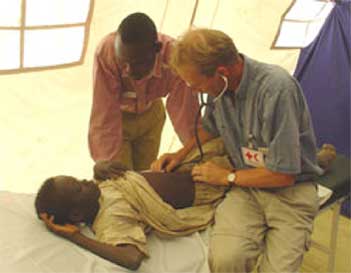What are the Symptoms?
The symptoms of malaria are very similar to many other common illnesses. So what makes malaria different? To understand why malaria is such a serious illness, you need to understand how the infection affects the body.
There may be anywhere between 7 and 60 days between the time of the bite by an infected mosquito and the appearance of malaria. The first symptoms include fever, chills, sweating, headache and body aches, nausea and vomiting, and a general lousy feeling. In regions with few cases of malaria, such symptoms indicate the onset of influenza (the flu) or a number of other common illnesses. But in subtropical and tropical countries, these symptoms mean only one thing: malaria.
If the illness remains untreated, the symptoms can develop into a series of distinctive recurrent attacks called paroxysms. The attacks consist of three stages. Violent chills mark the first stage, along with a headache, nausea, and vomiting. This lasts about one or two hours. In the second stage a high fever develops, marked by hot, dry skin. The fever breaks in the third stage, leading to a drenching sweat. At this point the person with malaria feels weak and tired and falls asleep. The paroxysm lasts roughly 6 to 10 hours. These attacks recur approximately every two days for malaria caused by Plasmodium vivax and P. ovale, and every three days for P. malariae. Between attacks the person feels fine. Within a few weeks the attacks go away.
|
Photo courtesy of IFRC. In eastern Chad at a Red Cross camp for refugees from Sudan, a young boy is examined for malaria. Young children are among the most vulnerable to the disease, and need to be treated promptly. |
Although considered to be typical symptoms of malaria, paroxysms rarely occur in real life. If they occur, paroxysms are more likely to develop with infections by P. vivax and P. ovule. P. falciparum causes sickness even between attacks, and an infected person can rapidly die if he or she doesn’t get treatment. Death rarely occurs from the other forms of malaria.
The reason for these differences lies in how the parasite infects the red blood cells. P. vivax infects only young blood cells, while P. falciparum infects red blood cells at all stages. Red blood cells normally live about 120 days. This means that while P. vivax attacks only some blood cells, all blood cells can be infected by P. falciparum. With so many parasites in the blood, the immune system struggles to control the infection.
If infection with the P. falciparum parasite is a possibility, immediate treatment is extremely important. Malaria caused by this parasite can develop into a severe, life-threatening form of malaria that can cause organ failures, metabolism problems, and blood abnormalities. Symptoms include severe anemia, blood in the urine, fluid in the lungs or acute respiratory distress syndrome, blood clotting problems, shock and cardiovascular collapse, and cerebral malaria, which causes odd behavior, seizures, and coma. Other indications of P. falciparum malaria include kidney failure, low blood sugar levels, high blood acidity, and the presence of the parasite in more than 5% of red blood cells.
Once severe malaria develops, treatment becomes a matter of life and death. According to the World Health Organization, if left untreated, severe malaria is fatal almost 100% of the time. With treatment, the percentage of deaths from severe malaria falls to 15% to 20%. The severe form of malaria most often develops in people with little or no immunity to P. falciparum. This category includes people who come from areas with no malaria, very young children, and pregnant women. The weakened immune system of pregnant women leaves them particularly vulnerable to severe malaria, especially in the second and third trimesters. Up to half the pregnant women who contract the illness die from it despite treatment. Severe malaria can cause premature labor and the death of the baby.
Different parasites dominate different regions. It is important to know which parasite is most common, and where it is most common.
This content has been re-published with permission from SEED. Copyright © 2025 Schlumberger Excellence in Education Development (SEED), Inc.


